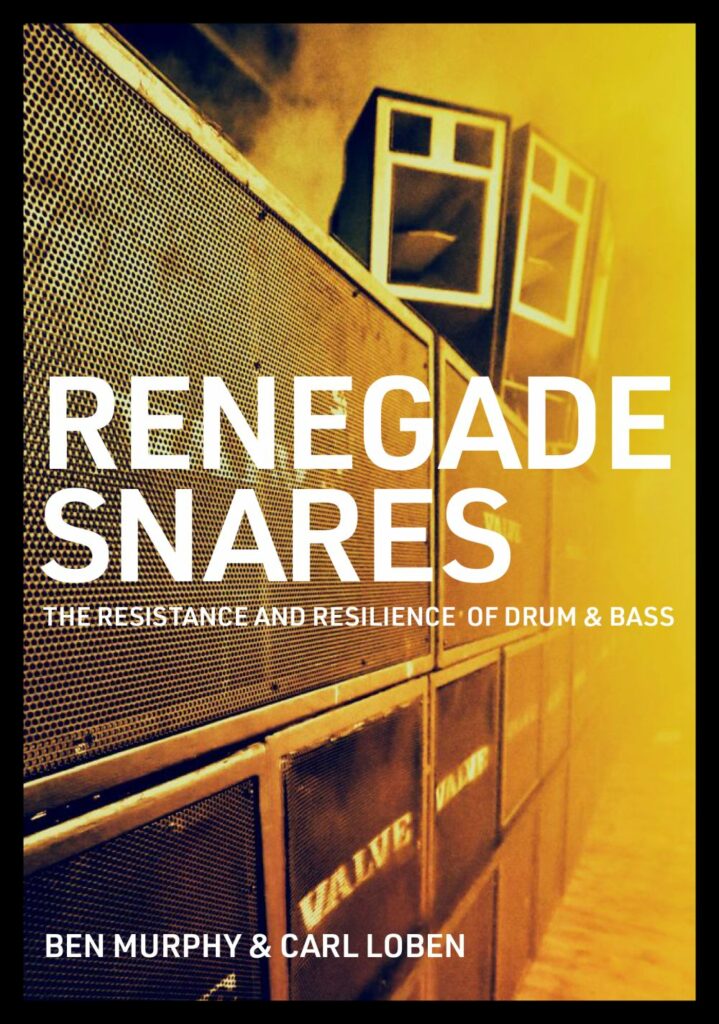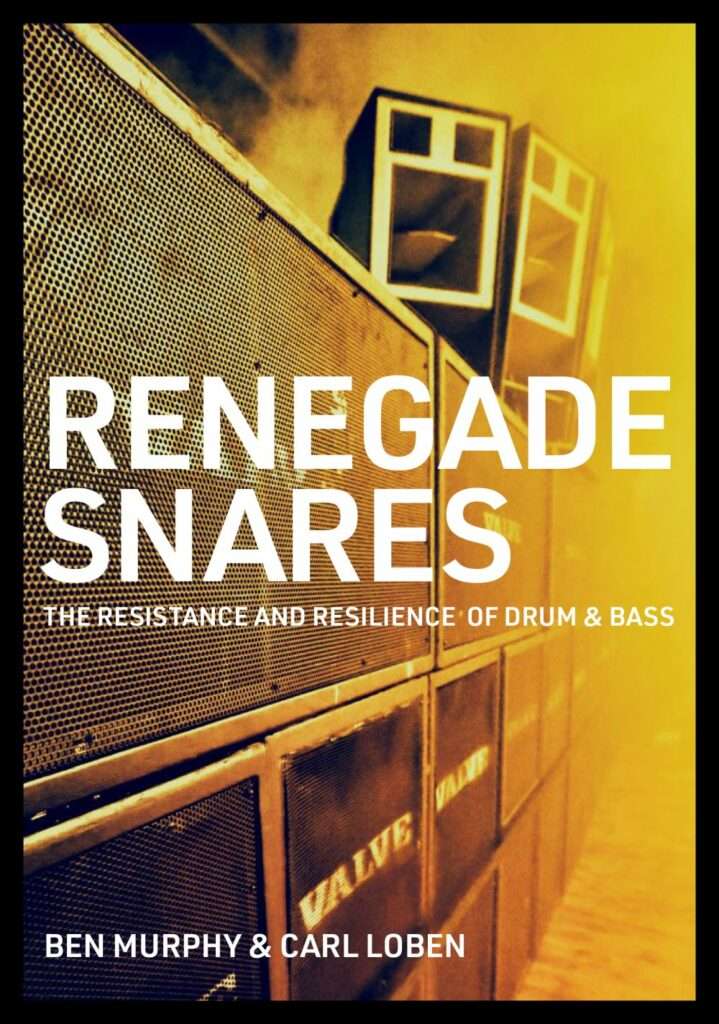
If anyone is qualified to write a definitive book about the history and culture of a given EDM genre, it’s Ben Murphy and Carl Loben, the former and current Editors-In-Chief, respectively, of DJ Mag. Lucky for drum & bass and its denizens that these two pillars of rave news also happen to be heads. Their hotly anticipated book, Renegade Snares: the Resistance and Resilience of Drum & Bass is out today, September 17.
Those who have read Renegade Snares are lauding the book as one of the most culturally significant since Brian Belle-Fortune’s All Crews: Journeys Through Jungle/Drum & Bass Culture, which published in 2004. With an emphasis on culture and influence, especially as it relates to Black music, Loben and Murhpy use definitive tracks, interviews – both new and from their extensive archives – and club culture to tell the story of one of the world’s most dynamic EDM genres.
It was its authors’ intention for Renegade Snares to be both a clear history/culture lesson (or review, if you’re old school) and an entertaining page-turner. Stuffed full of interesting factoids about how important tracks were made, new and novel perspectives from the progenitors themselves and vivid descriptions of early club culture right the way through to the massive festivals of today, the book is a must-read for any lover of D&B and the larger rave scene
Your EDM was lucky to sit down with the busy DJ Mag bosses right before the book went live to get some insight on the process, the culture and, of course, the amazing music that make drum & bass what it is. Read and learn, dear children of bass.
Very cool idea to title the book after legendary the Omni Trio track. What about “Renegade Snares” did you feel made it the one to encapsulate the book and the history of D&B?
Ben: Well, apart from it being one of the best early jungle/D&B tunes ever – especially Foul Play’s remix version – we felt there was a powerful resonance to the title. When I interviewed Omni Trio, he talked about the independent, renegade nature of the music, how it sat outside the mainstream and caused a revolution culturally. So not only are the beats rebellious in sound, but the genre changed society in the UK to some extent. We felt it encapsulated the whole idea.
Speaking of definitive D&B tracks, there’s a lot of space dedicated to analyzing important tracks in the book. Why did you think it was important to tell the tale of the genre’s evolution through its tunes in this way?
Carl: Yes, there’s a lot of vivid descriptions of tracks in the book, often with info about what rudimentary equipment they were made on and so forth. We felt it was important to cover the sonic evolution of the genre, but also there are a number of social issues that came into play as well: the outlaw nature in its early days, how it was a totally mixed black/white cultural melting pot to begin with, how the mood music changed before the Millennium, how it protected itself from external commercial cash-ins and so on.
Ben: To me, the way the sound evolved in all these individual steps, and how the tunes were created is fascinating. It’s incredibly intricate, futuristic music that deserves to be seen as such. But we wanted to focus on the DJs, producers, MCs and other scene leaders too, so their words tell a considerable amount of the story too.
To that end, if you had to each give a few tracks that really drove drum & bass forward in any era more than the others, which would they be and why?
Ben: A Guy Called Gerald “28 Gun Badboy” is one of the tunes that started jungle, moving on from hardcore. Its sparseness, heavy dub bass and spacey bleeps still sound so far ahead, I find it weird that most people know Gerald for “Voodoo Ray” instead. LTJ Bukem “Music” is the sublime start of the ambient jungle strain that he created, and no one had done anything like it before, with its echoing techno loops, rolling breaks and mesmeric atmosphere. Photek “Seven Samurai” did new things with beats, those drums that cascade and clash like katana blades…it caused other producers to up their game.
Clearly you both have a bit of an access advantage being current and former DJ Mag editors to be able to amass so much interview footage, but do you think having all that material through the years made it difficult to narrow it down?
Carl: It was definitely an advantage for us to have followed jungle/drum & bass since the mid-90s, not just as fans but as writers too. We knew the arc of the story from having interfaced with it closely over the years, and it was a question of attempting to tell the story faithfully through the eyes — and words — of the scene’s principle playas.
Ben: We actually did most of the interviews from scratch, but supplemented them with archive material where it was appropriate or where we weren’t able to get in touch with people.
Did you feel a duty to stuff as much interview material as you could in or was it more about finding things that related to the main points of the book?
Ben: To start with I wanted to include everything, but a lot of material ended up on the cutting room floor, as I came to realize you have to tell the story rather than just putting things in for the sake of it.
Carl: Yeah, we definitely had too much material; it was a case of whittling down to fit the word length whilst still trying to do justice to all the people featured.
One really important point of the book is around drum & bass’s being sired in and growing up around Black culture, as well as the dangers of gentrifying or whitewashing it. In your opinions, why is it important to remind the world that “jungle (and D&B) music is black music?”
Ben: Because as we get further away from the origins of the scene – the jungle scene in ’91, but hardcore earlier than that, and the music that came before it, such as UK house, reggae and hip-hop – people are less aware of its black origins and innovators. Younger readers who are discovering the sound may not know about the originators and how the sound came into being.
We go into a lot of depth about the ’80s in the UK too, and how African American music was a huge influence in the UK, and Jamaican culture obviously. The constituent elements of what jungle/drum & bass is — influences from house, techno, hip-hop, dub, dancehall, soul, funk — are almost all forms of music that were created by black people. It’s vital to get this across at a time when club and festival lineups don’t reflect cultural diversity enough, although there seem to be some who are addressing this more now.

Sadly, this book may be the first time some punters are learning about D&B’s cultural roots. Did you feel a duty to really drive home these points because of that?
Ben: Definitely.
Carl: Yes, definitely. One of the things I loved about drum & bass in its early days was its multi-cultural nature, and I remember thinking in the 1990s “Surely this is one genre that can never be ‘whitewashed’” because there were so many Black pioneers in the scene. However, as happened in history with various other music genres with Black origins — from jazz, blues and rock & roll to house and techno later on — a number of different factors led to co-option by the mainstream to an extent. So yes, we did feel it important to highlight the roots of the sound, very much so.
Aside from us press people making sure we give due coverage, what are some things you think the D&B community can do to make sure the black voice and black talent aren’t buried as our musical and cultural timeline continues?
Ben: Club-nights like Rupture are already making sure their lineups are ethnically mixed with a lot of Black DJs represented, in addition to more women, who have also been underrepresented in D&B. As a result, their club crowds are more mixed too. It would be good to see more clubs and festivals follow suit.
Carl: The scene itself, via initiatives like EQ50 and the Black Junglist Alliance is attempting to address these issues. The D&B community will hopefully keep evolving itself to continue redressing the balance.
Speaking of culture, the way D&B has developed has been quite political at times and certainly left its mark, especially in places like the UK. Why do you think, as a genre, it’s been so important in those realms?
Carl: Jungle/drum & bass evolved completely outside the mainstream, both within the music industry and also the wider society at large. Its independent DIY nature made it revolutionary in itself; never mind the sonic frontiers it’s been pushing. To this day it attracts its fair share of “outsiders”; people dissatisfied with more mainstream genres of electronic music, alternative types, people who enjoy a rowdy, kick-ass party. Its influence on other genres from garage to bass house to dubstep, grime and beyond is something we dwell on in the book, and ultimately we celebrate it as a futuristic sound that helped change the world in its own particular way.
Ben: Hardcore rave culture and later jungle/D&B was the first time you had really ethnically diverse crowds dancing together in the UK. In the ’80s, clubs often had racist door policies. Raves broke down this barrier. It built bridges between people across class lines, too. Unsurprisingly, raves were clamped down on by hostile governments. Pirate radio was independent art and communication that the authorities tried to crush. These things have never been liked by the powers that be, as they exist outside their control and are often counter to their beliefs.
If you had to predict where D&B is headed in the next decade in just a few words and/or a recent track, what would you choose/say?
Ben: I think there are some fascinating musical hybrids happening and DJs like Sherelle mixing jungle/D&B with footwork and techno. Then there are people like Aya/LOFT, Itoa and Sully doing quite new things with breaks. There’s always new things possible within the genre, which makes it so consistently exciting.
Carl: Headlong into the phuture.
Renegade Snares: the Resistance and Resilience of Drum & Bass is out now in the UK and will drop in October for the US on Jawbone Press. Click here to order/pre-order.


